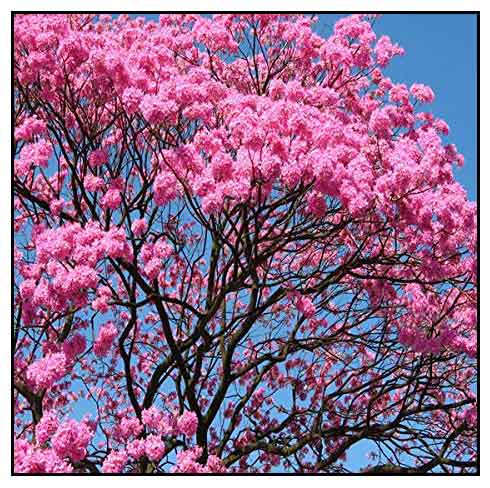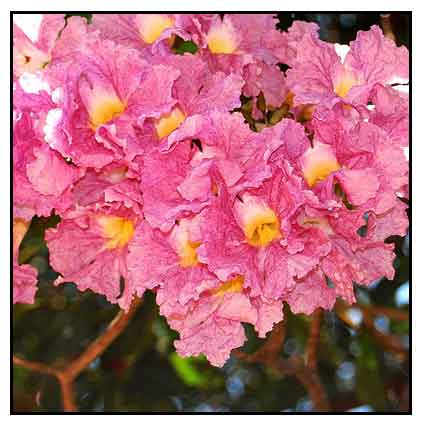 Gen info Gen info
- Tabebuia is a genus of flowering plants in the family Bignoniaceae. The genus consists almost entirely of trees, with a few large shrubs. (19)
- There are over 100 types of trumpet trees in the genus Tabebuia.
- Etymology: The genus name is derived from Tupi words for "ant" and "wood", referring to the fact that many Tabebuia species have twigs with soft pith that forms hollows within which
ants live, defending trees from other herbivores. (19) The genus name derives from the native Brazilian name 'tabebuia' or 'taiaveruia'. The species epithet 'rosea' means rose colored. (26)
- In 2007, about 30 species of trees in Tabebuia were reamed Handroanthus when molecular studies showed they were more closely related to genera other than Tabebuia. Hydroanthus can be distinguished by minute hairs on the leaves or flowers and extremely dense wood that yield copious amounts of the compound lapachol in the bark. Tabebuia is restricted to species with quite to red or rarely yellow flowers. (9)
- It is the national tree of El Salvador, where it is called "Maquilishuat."
 Botany Botany
• Tabebuia rosea is a neotropical semi-evergreen tree growing to a height of20 to 30 meters, with a gray-fissured trunk and a diameter at breast height of up to 100 centimeters.. Tree crown is wide with irregular, stratified ramifications and a few thick branches. Leaves are compound, palmately lobed, with five leaflets of variable sizes, the meddle being the largest. Flowers are large, pink to purple, with a white throat with yellow stripes blooming in large clusters when leaves are mostly shed, before new foliage emerges. Fruit are long and slender capsules, up to 35 centimeters long and 1 to 1.5 centimeters wide, dehiscing when dry to release numerous hyaline membrane-winged seeds. (3)
• Growth form: A medium to big deciduous tree. Foliage: Leaves are oppositely arranged, palmately compound with 5 leaflets on each stalk. Leaflets are 5 - 22 cm by 2 - 11 cm, oblong to elliptic in shape, with pointed ends. Flower: Flower is trumpet-shaped with 5 petals, 5 - 8 cm long, large and showy. Fruits: Fruits split open when matured, and the seeds are attached to the central wall. Seeds have winged features, which are dispersed by wind. (26)
Distribution
- Introduced.
- Cultivated, not naturalized.
- Ornamental cultivation for their spectacular flowers.
- Native to South America, from Argentina through Central America to Mexico.
- Planted in parks and garden as a shade tree for the rainy season.
 Constituents Constituents
- GC-MS analysis of ethanol extract of leaves yielded major chemical constituents of 2-furancarbox-aldehyde, 5-hydroxy methyl (19.39%), 2-deoxy, D-erythropentose (11.01%), Santolina triene(8.28%), 4H-Pyran-4-one, 2,3-dihydro-3,5-dihydroxy-6-methyl (6.07%), 7-Quinolinol (6.01%), phenol, 2-(2-methyl propyl) (5.41%) and Cinnamaldehyde (2.42%). Extract was characterized by active compounds such as aromatic aldehydes (21.81%), sugar (11.01%), aromatic compounds (7.28%), terpenoids (8.3%), quinone (6.01%), alkanes (6.35%), phenolics (6.85%) and flavonoid (6.07%).. (4)
- Preliminary screening of leaves yielded saponins tannins, phenolic acids, flavonoids, and alkaloids.
(see study below) (5)
- Mass spectral fragmentation studies were done on dehydro-α-lapachone and dehydro-iso-α-lapachone, isolated from heartwood of Tabebuia rosea. Fragmentation of the two compounds were essentially similar. (17)
- Phytochemical profile revealed presence of alkane, sugar glycoside, phenol, flavonoid, heterocyclic quinoline, phenolic aldehyde, aromatic compound, coumarin, phenolic acid, sugar, fatty alcohol, epoxide, essential oil, with absence of resin and steroid. (20)
- GC-MS analysis of ethanolic leaf extract yielded major chemical constituents of
2-furancarbox-aldehyde, 5-hydroxy methyl (19.39%), 2-deoxy, D-erythropentose (11.01%), Santolina triene(8.28%), 4H-Pyran-4-one, 2,3-dihydro-3,5-dihydroxy-6-methyl (6.07%), 7-Quinolinol (6.01%), phenol, 2-(2-methyl propyl) (5.41%) and Cinnamadehyde (2.42%). The extract was characterized by various types of active compounds such as aromatic aldehydes (21.81%), sugar (11.01%), aromatic compounds (7.28%), terpenoids (8.3%), quinone (6.01%), alkanes (6.35%), phenolics (6.85%) and flavonoid (6.07%). (22)
- Phytochemical analysis of seed extract yielded cardioglycosides, coumarins, essential oil/volatile oil, flavonoids, flavons, phenols, steroids, tannins, terpenoids, with absence of anthocyanins, carotenoids, chalcones, anthraquinones, emodin,
phlobatannins, saponins, and starch. (25)
Properties
- Studies have suggested antibacterial, anti-inflammatory, antiproliferative, antioxidant, hepatoprotective, anticancer, antiobesity properties.
Parts used
Bark, leaves, flowers, roots.
 Uses Uses
Folkloric
- No reported medicinal use in the Philippines.
- Decoction of dried and shredded inner bark makes a bitter brown-colored tea, taheebo or lapacho, taken for flu and smoker's cough. Also used for treating ulcers, syphilis, gastrointestinal problems, candidiasis, cancer, diabetes, prostatitis, constipation and allergies. (4)
- In the early 80s, lapacho was used in the treatment of cancer and AIDS, but later discouraged because of the toxicity of the main active component, lapachol, which was reported to cause death. However, there continues to be use of Lapacho tea in Indian medicine as antimicrobial against Pneumocystis pneumonia in AIDS.
- Decoction of bark used to treat intestinal parasites, anemia and constipation. (3)
- Decoction of flowers, leaves and roots used to reduce fevers and pain, treat tonsil inflammation.
Others
- Wood: Timber is widely used for general construction and carpentry in Europe.(•) It is one of the hardest and densest on earth. Used i the tropics for making bows, boats, railroad ties and tool handles. Wood is insect and fungus resistant. It has been a major cause of deforestation in the Amazon. (9)
- Herbal products: Tree bark used for making herbal products: taheebo, lapacho, pau d'arco and ipe roxo.
Toxicity concerns
- Possibly unsafe at high doses.
- Lapachol, the main active component in the bark and wood, is toxic; its strong antibiotic and disinfectant properties are better suited for topical applications. (9)
Studies
• Antibacterial / Leaves: Study evaluated an ethanolic leaf extract of T. rosea for antibacterial activity. In-vitro antibacterial studies were done on ten medically important bacterial strains viz., Salmonella typhimurium, Pseudomonas aeruginosa, Klebsiella pneumonia, Escherichia coli, Pseudomonas sp., Staphylococcus aureus, S. epidermis, Micrococcus luteus, Streptococcus sp and Bacillus subtilis. Results showed good inhibitory activity against all tested pathogens compared with standard streptomycin and penicillin. Activity was dose dependent. (5)
• Antioxidant / Anti-Inflammatory / Antiproliferative / Leaves and Inner Bark: Study evaluated the antioxidant, anti-inflammatory and antiproliferative potential of leaf and inner bark extracts of T. rosea. An ethyl acetate extract showed highest DPPH radical scavenging activity (IC50 157.5 ± 2.4 µg/mL) and induced best antioxidant activity by ORAC. Inner bark extracts inhibited prostaglandins E2 and tumor necrosis factor alpha (>90%). Best antiproliferative activity was displayed by inner bark chloroform extract against HepG2 cell lines. (6)
• Nrf2-Medicated Antioxidant Activity / Inner Bark: Study evaluated the Nrf2-mediated antioxidant activity of inner barks from Tabebuia rosea and T. chrysantha using ORAC (oxygen radical absorbance capacity) technique. The EA extract from both species displayed highest ORAC activity (12,253 and 6,325 µmoles Eq Trolox/g extract). The extracts exhibited antioxidant effect mediated by Nrf2 activation, and has potential as new source of natural antioxidants. (7)
• In-Vivo Anticancer Activity / Dalton's Ascetic Lymphoma / Leaves: Study evaluated the possible antitumor effect and antioxidant role of methanolic extract of T. rosea leaves against Dalton's ascetic lymphoma (DAL) induced Swiss albino mice. Results showed significant antitumor and antioxidant activity in vivo. (8)
• Antimicrobial / Flowers: Study evaluated the antimicrobial effect of an ethyl acetate fraction of flowers of Tabebuia rosea against four bacteria (S. typhi, E. coli, E. faecalis, B. cereus) and two fungal strains (C. lunata and C. albicans). The antibacterial activity was almost comparable with solvent control chloramphenicol and the antifungal activity was almost comparable to fluconazole. (10)
• Antioxidant / Flowers: Study showed ethanol extracts of Tabebuia rosea and T. argentea exhibited strong antioxidant activities by DPPH, hydroxyl radicals, metal chelating, ferric thiocyanate assays. (11)
• Larvicidal / Antioxidant / Dried Flowers: Study evaluated the larvicidal and antioxidant properties of methanol extract of dried flowers of T. rosea. Results showed larvicidal activity against Culex quinquefasciatus and Anopheles subpictus with regression value of 0.974 0.981 and LC50 of 586.68 and 241,72, respectively. (12)
• Anthelmintic / Flowers: Study evaluated the anthelmintic activity of methanol extract of leaves of T. rosea against adult earthworm, Pheretima posthuma. Albendazole was used as standard. Results showed significant anthelmintic activity in measures of paralysis and death of earthworms. (13)
• Anxiolytic / Behavioral and Muscle Coordination Effects / Leaves: Study of methanol the of methanol extracts of leaves using various CNS models in mice showed significant protective effect behavioral, muscle coordination and anxiolytic activities. (14)
• Prospective Non-Edible Biodiesel Feedstock / Seed Oil: Study evaluated T. rosea seed oil as potential non-conventional feedstock for preparation of biodiesel. Analysis showed the tested parameters were comparable with ASTM and IS standard specifications for biodiesel samples. Results showed T. rosea seed oil is a satisfactory feedstock for biodiesel production. (15)
• Hepatoprotective / Paracetamol Induced Hepatotoxicity: Study evaluated the hepatoprotective activity of methanolic extracts of T. rosea and Solanum pubescens against paracetamol induced liver damage in rats. Results showed hepatoprotective activity as evidenced by significant reduction in serum enzymes ALT, AST, ALP and total bilirubin. (16)
• Anticancer / Human Liver Cancer / Flowers: MTT assay of flowers of Tabebuia rosea against liver cancer HepG2 cell line showed significant results. All concentrations (62.5 µg/ml to 1000 µg/ml) showed anticancer activity with CTC50s range from 74.95 µg/ml to 43.86 µg/ml against human liver cancer HepG2 cell line. (18)
• Anti-Obesity: An ethanol extract of T. rosea (TrEtOH) produced significant decrease in body weight (12.1%) and diminution in lipid profile markers in high-fat diet-induced obese C57BL/6 mice. There was reduction in number of hypertrophic adipocytes and decrease of triglycerides in adipose tissue, and reduction in size and fat in hepatocytes. TrEtOH administration led to mRNA over-expression of UCP1, TBX1, and GLUT4, suggesting promotion of adipocyte browning as possible mechanism of action. The TrEtOH did not show mutagenicity, genotoxicity, or toxic effects after acute or 28-day repeated administration. Results suggest potential for development of new drugs against obesity and its co-morbidities. (21)
• Anti-Inflammatory / Anti-Obesity / Bark: Study evaluated of ethanolic extract of T. rosea and quercetin on the mRNA of inflammation markers in obesity compared to drugs currently in use. Rats treated with T. rosea and quercetin showed 36% and 31% reductions in body weight compared to obese control, and showed inhibition of pro-inflammatory molecules: II6,II1b, II18, Lep, Hif1a, and Nfkb1 without modifying the expression of pro-inflammatory genes, modifying signaling pathways, which led to the regulation of obesity-inflammation state. (23)
• Silver Nanoparticles / Antibacterial, Antioxidant, Antiproliferative / Seeds: Study reports on the green synthesis of silver nanoparticles using Tabebuia rosea seeds as reducing agents. Antimicrobial activity assay showed antibacterial activity against K. pneumonia with maximum inhibition zone of 20 mm, followed by E. faecalis, P. aeruginosa, P. mirabilis and S. aureus at highest concentration of 100 mg/ml. DPPH assay showed unique scavenging activity at maximum concentration of 500 µg/ml at 80.98%. The AgNPs showed cytotoxicity effect with IC50 of 45 µg/mL following 24 h treatment with human fibroblast cells (L929). Results suggest potential applications as nano drugs. (24)
Availability
- Cultivated.
- Seeds in the cybermarket. |

![]()







